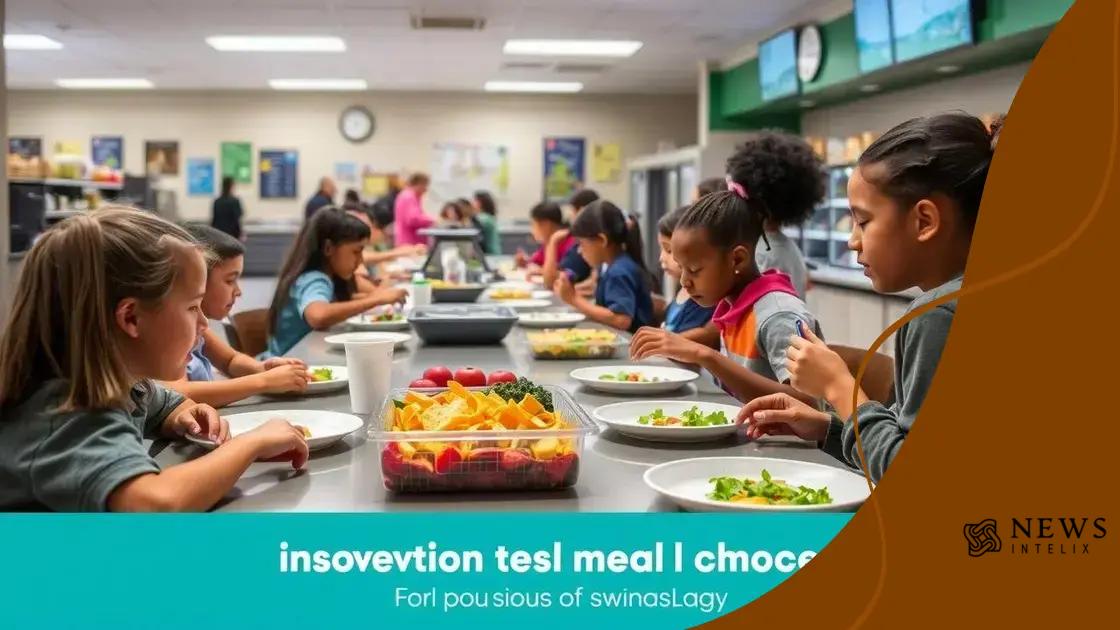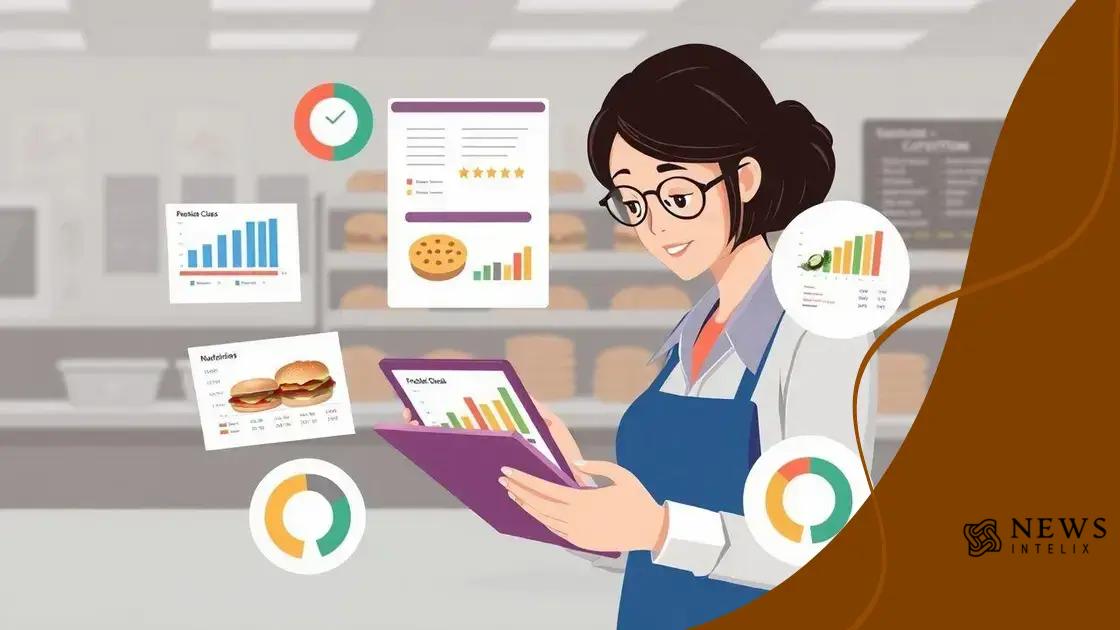School meals get tech boost for healthier choices

School meals get tech boost through innovations like smart cafeterias and mobile apps, enhancing meal planning, promoting healthier eating, and increasing student engagement in food choices.
School meals get tech boost as new technologies transform how students experience nutrition. Imagine a system where kids not only enjoy delicious meals but also learn about healthy eating through interactive platforms. Curious to see how this is happening? Let’s dive in.
The role of technology in modernizing school meals
In today’s world, technology plays a vital role in modernizing school meals. Schools are beginning to leverage innovative solutions to enhance the dining experience for students. With new tools and platforms, schools can provide healthier and more appealing meal options.
Smart meal planning systems
These systems utilize data to ensure that students have access to balanced and nutritious meals. By analyzing dietary needs and preferences, schools can tailor menus that cater to their students’ tastes and nutritional guidelines.
- Increased student satisfaction
- Improved nutritional quality
- Efficient inventory management
Moreover, technology helps in tracking meal consumption. Schools can gather data about what meals are popular, allowing them to adjust offerings based on student feedback. This not only maximizes resources but also minimizes waste.
Interactive dining experiences
Another exciting aspect is the development of interactive platforms. These platforms educate students about nutrition through engaging apps and games. Kids learn while they eat! They can explore food origins, understand healthy choices, and even customize their meals.
- Fun learning about nutrition
- Empowerment in food choices
- Encouraging a healthy lifestyle
As schools adopt these modern technologies, they not only improve meal quality but also promote better health practices among students. Such initiatives foster a generation that values nutritious eating habits.
Benefits of tech-enhanced nutrition programs
The benefits of tech-enhanced nutrition programs are becoming clear as schools adopt innovative solutions to improve student meals. These programs not only promote healthier choices but also create a more engaging dining experience for children.
Promoting healthier eating habits
With the incorporation of technology, students have access to information that encourages them to make better dietary choices. For example, apps that educate kids about the nutritional value of foods foster awareness about healthy eating.
- Accessible nutrition education
- Real-time feedback on food choices
- Incentives for making healthier selections
As children learn about nutrition, they become more likely to choose fruits and vegetables over processed options. This change not only benefits their health but also sets the foundation for lifelong healthy habits.
Increased efficiency in meal preparation
Technology streamlines meal prep and planning. Schools can track inventory and demand, leading to less waste and better resource management. This efficiency means schools can allocate their budgets more effectively, ensuring that funds are directed towards fresh and nutritious options.
- Reduced food waste
- Better budgeting for meals
- More fresh ingredients available
Moreover, this technology also allows for personalized meal plans to meet dietary needs. Students with allergies or special diets can have their meals tailored, ensuring everyone has access to safe and satisfying options.
How schools are using data to improve meal planning

Schools today are increasingly using data to improve meal planning. By gathering information on student preferences and nutritional needs, they can create meals that are not only delicious but also healthy.
Understanding student preferences
Data collection begins with understanding what students like to eat. Schools can utilize surveys and feedback tools to find out which dishes are popular. This information helps in planning menus that appeal to students.
- Customized meal options based on feedback
- Increased student satisfaction through preferred choices
- Minimized food waste with selected dishes
By providing meals that students enjoy, schools see a higher participation rate in meal programs, which in turn supports better funding and resource allocation.
Analyzing nutritional data
Another key aspect is analyzing the nutritional data of each meal. Schools can ensure they meet dietary guidelines by assessing the ingredients and portion sizes. This focus on nutrition helps build strong eating habits among students.
- Balanced meals that promote overall health
- Tracking dietary restrictions for safe options
- Encouraging variety in the food provided
The data analysis can also reveal trends over time, allowing schools to adjust menus each semester. This agility enables them to respond to changing tastes and health recommendations effectively.
Success stories: Tech innovations in school dining
Across the country, success stories of tech innovations in school dining are emerging, showcasing how technology can transform the way students experience meals. These examples illustrate the positive impact of integrating technology into school nutrition programs.
Case Study: Smart Cafeterias
One notable example is the implementation of smart cafeteria systems in various districts. These systems use touchless payment options and digital menu boards to streamline the dining experience. Students can quickly pay for meals using their student IDs, minimizing wait times and making lunch more enjoyable.
- Faster service during peak hours
- Reduced frustration for students and staff
- More efficient use of staff resources
Additionally, digital menu boards can showcase meal options and nutritional information, encouraging healthier choices among students. This visual engagement can lead to an increase in the selection of fruits and vegetables.
Mobile Apps for Meal Selection
Another innovation involves mobile apps that allow students to pre-order meals. These apps provide a platform for students to choose their lunch options ahead of time, ensuring they get what they want. This also helps schools manage food inventory more effectively.
- Improved meal satisfaction
- Less food waste from inaccurate counts
- Enhanced student involvement in meal planning
Such initiatives give students a sense of ownership over their meals, fostering positive eating habits.
Empowering Nutrition Education
Some schools have also adopted interactive learning platforms that educate students about nutrition. For instance, gamified applications provide fun activities related to healthy eating. Students learn about the food pyramid and the importance of balanced meals while engaging in enjoyable challenges.
- Engaging students in nutrition education
- Inspiring a healthier lifestyle
- Fostering teamwork through group challenges
These tech innovations not only enhance meal offerings but also actively contribute to healthier communities.
Challenges and solutions in implementing tech in school meals
Implementing technology in school meals presents both challenges and solutions that schools must navigate to improve student dining experiences. Understanding these obstacles is key to making effective changes.
Common challenges faced
One major challenge is the cost of technology. Many schools have limited budgets, making it difficult to invest in new systems or software. Schools need to weigh the immediate costs against the potential long-term benefits.
- High initial setup costs
- Ongoing maintenance expenses
- Need for staff training
Another issue is resistance to change. Some staff and students may prefer traditional meal systems and may not see the benefits of adopting new technologies. Educating them on these benefits can help ease the transition.
Proposed solutions
To address financial constraints, schools can seek grants or partnerships with local organizations. Many companies are willing to fund pilot programs that demonstrate the effectiveness of technology in enhancing school meals.
- Grant applications for funding
- Partnerships with tech companies
- Community fundraising initiatives
Additionally, ongoing education and training for staff are essential. Providing workshops can help staff feel more comfortable using new technologies. This leads to smoother implementation and improved acceptance among students.
It is also beneficial to pilot new programs on a small scale before a full rollout. This allows schools to gather feedback, make adjustments, and demonstrate success to the wider community.
FAQ – Frequently Asked Questions about Technology in School Meals
What are the benefits of using technology in school meal programs?
Technology enhances meal planning, promotes healthier eating habits, and improves student engagement in their food choices.
How can schools overcome the cost of implementing new technologies?
Schools can seek grants, form partnerships with local organizations, and explore community fundraising to support technology initiatives.
What challenges do schools face when adopting new meal technologies?
Common challenges include high initial costs, resistance from staff and students, and the need for staff training.
Can interactive learning applications make nutrition education more engaging?
Yes, interactive applications gamify the learning process, making nutrition education fun and impactful for students.
